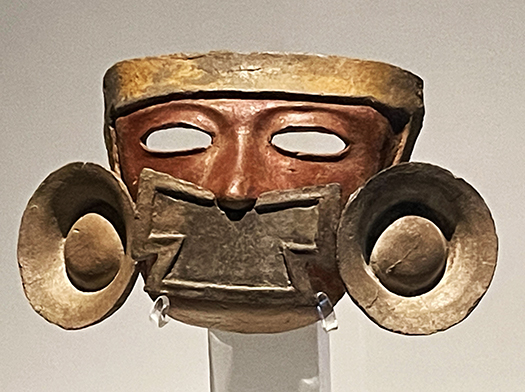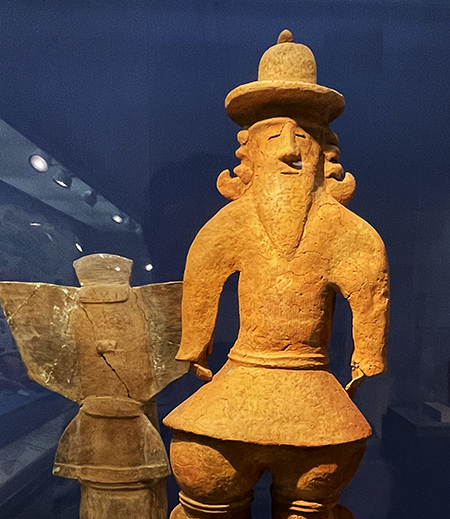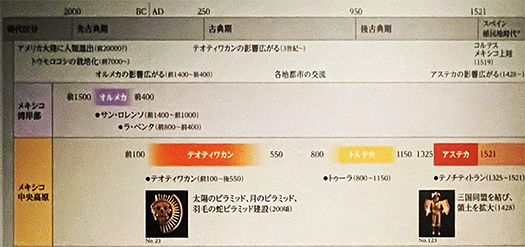

世界史の学習ではおおむね西洋史が基本の流れとして把握されて、中国史や日本史上の出来事がそれとの対比として認識されるのが一般的な歴史学習。そういう基本の流れとは異質な古代メキシコを見ていくとすれば、やはり日本史との時系列対比がいちばんしっくりくるのではないか。
メキシコでは先史文化としてBC1500年頃からBC400年頃までオルメカ文化が存在した。しかしメキシコ展でも明示的な物証としては文化例証は示されなかった。日本史で言えば、縄文晩期から弥生文化期に相当するのだろう。この時期でも日本史では三内丸山や吉野ヶ里などの大規模文化痕跡を見出しうる。
上の写真は展示会での古代メキシコ・テオティワカン文化の「マスク」。AD350-550年頃のものと特定され、神官か戦士を表しているとされている。この文明の精神構造をその表現方法で伝えてくれていると感じた。対比させたその下の写真ははにわ像作品。同時期の日本文化のものとして、いろいろ考えられたが、ここでは芝山はにわ博物館のはにわ像に代表していただいた(笑)。
東北大学の田中英道名誉教授の説ではモデルは「ユダヤ人」説が唱えられている有名な一作。後述するけれどテオティワカンなどのメキシコが「孤立した文明」であったのに対して日本は「交流のるつぼ」であったことを伝えてくれている。そうではあるけれど、その造形感覚において近しいように思われるのですね。


きのうもイントロ的に日本民族とアメリカ大陸に渡ったかれらとのDNA的な近さを見た。そういえば1521年のスペインによる植民地化という大変動は、同時に日本社会では鉄砲の伝来などの西洋文明との遭遇期でもあり、日本は独立を維持できたけれどメキシコは植民地化されてしまった。
日本史が継続的に大陸国家にして「中華思想」という周辺にとっては迷惑極まりない世界皇帝志向型の強権国家・中国との逃れがたい国際関係を経験したことで、国家意識・独立意識が鍛えられていったのに対して、有力な国際関係経験を持てなかったかれらには、スペインによる侵略、西洋近代から突然の文明的国際関係がまったくの対外関係「初体験」だったのかとも思える。少なくとも、同時期にアメリカ大陸では文明の生存に関わるような「国際」関係認識・調整能力というようなものは発達していなかった。
もっと古代でのエジプト、メソポタミアといった地域ですら「文明間の対話」というような意識はあったものが、この中米地域では存在しなかったのではないだろうか。
もう少し対外関係の経験があれば、わが国での聖徳太子のようにギリギリの外交交渉でねばるという知恵もあり得たのかも知れない。ただ、日本も距離的に中華文明とほど近く、漢字の受容、仏教の伝来などの「交流」を経験していたとはいえ、ある程度は「孤立した島国」であって、このはるかな中米文化に対して「わかる」「通じる」部分も持っているように思う。
English version⬇
Teotihuacan ⇔ Yayoi – Kofun Period Ancient Mexico-2
This is a series of articles contrasting ancient Mexican culture with Japanese culture of the same period. This is an experimental contrast to see how two cultures that are closely related by DNA could be dissimilar in different environments. Ancient Mexico
In general, Western history is the basic flow of world history, and events in Chinese and Japanese history are generally considered in contrast to Western history. If we look at ancient Mexico, which is different from such a basic flow, a chronological comparison with Japanese history would be the most appropriate.
In Mexico, the Olmec culture existed as a prehistoric culture from around 1500 BC to 400 BC. However, there was no explicit evidence of this culture at the Mexican exhibition. In terms of Japanese history, the Olmec culture probably corresponds to the period from the Late Jomon to the Yayoi culture. In Japanese history, large-scale cultural traces can be found even in this period, such as at Sannai-Maruyama and Yoshinogari.
The photo above is a “mask” from the ancient Mexican culture of Teotihuacan, identified as dating from around AD 350-550, and said to represent a priest or warrior. I felt that it conveyed the spiritual structure of this civilization in the way it was expressed. The photo below, which I contrasted with the above, is a haniwa statue work. I could think of many possible Japanese cultural objects from the same period, but here I was represented by the haniwa statue at the Shibayama Haniwa Museum (smile).
According to the theory of Professor Emeritus Hidemichi Tanaka of Tohoku University, the model for this famous work is a “Jew. As I will explain later, the statue tells us that Mexico, including Teotihuacan, was an “isolated civilization,” while Japan was a “melting pot of exchanges. Although this is true, they seem to be close in terms of their sense of form.
Yesterday, too, we saw the DNA similarity between the Japanese people and those who came to the Americas. The colonization of Mexico by Spain in 1521 was, by the way, at the same time a period of encounter with Western civilization, including the introduction of guns, and although Japan was able to maintain its independence, Mexico was colonized.
While Japanese history had experienced the continuous international relations with China, a continental nation with a strong power that was oriented toward the emperor of the world, which was a nuisance to its neighbors, the “Chinese idea,” and this experience strengthened their sense of nationhood and independence, they had no experience with international relations, and they were not able to have a strong sense of international relations until the invasion by Spain, It seems as if the invasion by Spain and the sudden civilized international relations from the Western modern era were their “first experience” with foreign relations at all. At the same time, the Americas had not developed the ability to recognize and coordinate “international” relations that would affect the survival of their civilization.
Even in more ancient times, in regions such as Egypt and Mesopotamia, there was a sense of “dialogue among civilizations,” but this may not have existed in the Central American region.
If Japan had a little more experience in foreign relations, it might have had the wisdom to persist in last-minute diplomatic negotiations, as Prince Shotoku did in Japan. However, although Japan is close to the Chinese civilization in terms of distance and has experienced “exchanges” such as the acceptance of Chinese characters and the introduction of Buddhism, to some extent it is an “isolated island nation” that seems to have “understood” and “understood” some aspects of this faraway Central American culture.
Posted on 9月 18th, 2023 by 三木 奎吾
Filed under: 歴史探訪







コメントを投稿
「※誹謗中傷や、悪意のある書き込み、営利目的などのコメントを防ぐために、投稿された全てのコメントは一時的に保留されますのでご了承ください。」
You must be logged in to post a comment.